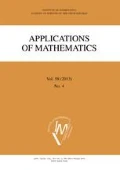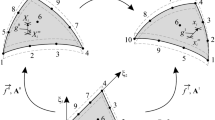Abstract
In this work, we address the problem of fluid-structure interaction (FSI) with moving structures that may come into contact. We propose a penalization contact algorithm implemented in an unfitted numerical framework designed to treat large displacements. In the proposed method, the fluid mesh is fixed and the structure meshes are superimposed to it without any constraint on the conformity. Thanks to the Extended Finite Element Method (XFEM), we can treat discontinuities of the fluid solution on the mesh elements intersecting the structure. The coupling conditions at the fluid-structure interface are enforced via a discontinuous Galerkin mortaring technique, which is a penalization method that ensures the consistency of the scheme with the underlining problem. Concerning the contact problem, we consider a frictionless contact model in a master/slave approach. By considering the coupled FSI-contact problem, we perform some numerical tests to assess the sensitivity of the proposed method with respect to the discretization and contact parameters and we show some examples in the case of contact between a flexible body and a rigid wall and between two deformable structures.
Similar content being viewed by others
References
C. Ager, B. Schott, A.-T. Vuong, A. Popp, W. A. Wall: A consistent approach for fluid-structure-contact interaction based on a porous flow model for rough surface contact. Int. J. Numer. Methods Eng. 119 (2019), 1345–1378.
C. Ager, A. Seitz, W. A. Wall: A consistent and comprehensive computational approach for general fluid-structure-contact interaction problems. Available at https://arxiv.org/abs/1905.09744 (2019), 34 pages.
P. Alart, A. Curnier: A mixed formulation for frictional contact problems prone to Newton like solution methods. Comput. Methods Appl. Mech. Eng. 92 (1991), 353–375.
F. Alauzet, B. Fabrèges, M. A. Fernández, M. Landajuela: Nitsche-XFEM for the coupling of an incompressible fluid with immersed thin-walled structures. Comput Methods Appl. Mech. Eng. 301 (2016), 300–335.
P. Antonietti, M. Verani, C. Vergara, S. Zonca: Numerical solution of fluid-structure interaction problems by means of a high order Discontinuous Galerkin method on polygonal grids. Finite Elem. Anal. Des. 159 (2019), 1–14.
D. N. Arnold, F. Brezzi, B. Cockburn, L. D. Marini: Unified analysis of discontinuous Galerkin methods for elliptic problems. SIAM J. Numer. Anal. 39 (2002), 1749–1779.
F. P. T. Baaijens: A fictitious domain/mortar element method for fluid-structure interaction. Int. J. Numer. Methods Fluids 35 (2001), 743–761.
S. Basting, A. Quaini, S. C’anic, R. Glowinski: Extended ALE method for fluid-structure interaction problems with large structural displacements. J. Comput. Phys. 331 (2017), 312–336.
Y. Bazilevs, V. M. Calo, Y. Zhang, T. J. R. Hughes: Isogeometric fluid-structure interaction analysis with applications to arterial blood flow. Comput. Mech. 38 (2006), 310–322.
Y. Bazilevs, M.-C. Hsu, J. Kiendl, R. Wüchner, K.-U. Bletzinger: 3D simulation of wind turbine rotors at full scale II. Fluid-structure interaction modeling with composite blades. Int. J. Numer. Methods Fluids 65 (2011), 236–253.
T. Belytschko, N. Moes, S. Usui, C. Parimi: Arbitrary discontinuities in finite elements. Int. J. Numer. Methods Eng. 50 (2001), 993–1013.
D. Boffi, L. Gastaldi: A finite element approach for the immersed boundary method. Comput. Struct. 81 (2003), 491–501.
D. Boffi, L. Gastaldi: A fictitious domain approach with Lagrange multiplier for fluid-structure interactions. Numer. Math. 135 (2017), 711–732.
D. Boffi, L. Gastaldi, L. Heltai: Numerical stability of the finite element immersed boundary method. Math. Models Methods Appl. Sci. 17 (2007), 1479–1505.
I. Borazjani: Fluid-structure interaction, immersed boundary-finite element method simulations of bio-prosthetic heart valves. Comput. Methods Appl. Mech. Eng. 257 (2013), 103–116.
I. Borazjani, L. Ge, F. Sotiropoulos: Curvilinear immersed boundary method for simulating fluid structure interaction with complex 3D rigid bodies. J. Comput. Phys. 227 (2008), 7587–7620.
E. Burman: Ghost penalty. C. R., Math., Acad. Sci. Paris 348 (2010), 1217–1220.
E. Burman, M. A. Fernández: Stabilized explicit coupling for fluid-structure interaction using Nitsche’s method. C. R., Math., Acad. Sci. Paris 345 (2007), 467–472.
E. Burman, M. A. Fernández: Stabilization of explicit coupling in fluid-structure interaction involving fluid incompressibility. Comput. Methods Appl. Mech. Eng. 198 (2009), 766–784.
E. Burman, M. A. Fernández: An unfitted Nitsche method for incompressible fluid-structure interaction using overlapping meshes. Comput. Methods Appl. Mech. Eng. 279 (2014), 497–514.
E. Burman, M. A. Fernández, S. Frei: A Nitsche-based formulation for fluid-structure interactions with contact. ESAIM, Math. Model. Numer. Anal. 54 (2020), 531–564.
E. Burman, M. A. Fernández, P. Hansbo: Continuous interior penalty finite element method for Oseen’s equations. SIAM J. Numer. Anal. 44 (2006), 1248–1274.
E. Burman, P. Hansbo, M. G. Larson: Augmented Lagrangian and Galerkin least-squares methods for membrane contact. Int. J. Numer. Methods Eng. 114 (2018), 1179–1191.
E. Burman, P. Hansbo, M. G. Larson: Augmented Lagrangian finite element methods for contact problems. ESAIM, Math. Model. Numer. Anal. 53 (2019), 173–195.
F. Chouly, M. Fahre, P. Hild, R. Mlika, J. Pousin, Y. Renard: An overview of recent results on Nitsche’s method for contact problems. Geometrically Unfitted Finite Element Methods and Applications. Lecture Notes in Computational Science and Engineering 121. Springer, Cham, 2017, pp. 93–141.
F. Chouly, P. Hild: A Nitsche-based method for unilateral contact problems: Numerical analysis. SIAM J. Numer. Anal. 51 (2013), 1295–1307.
F. Chouly, P. Hild: On convergence of the penalty method for unilateral contact problems. Appl. Numer. Math. 65 (2013), 27–40.
F. Chouly, R. Mlika, Y. Renard: An unbiased Nitsche’s approximation of the frictional contact between two elastic structures. Numer. Math. 139 (2018), 593–631.
F. Chouly, Y. Renard: Explicit Verlet time-integration for a Nitsche-based approximation of elastodynamic contact problems. Adv. Model. Simul. Eng. Sci. 5 (2018), Article ID 31, 38 pages.
J. Donea, S. Giuliani, J. P. Halleux: An arbitrary Lagrangian-Eulerian finite element method for transient dynamic fluid-structure interactions. Comput. Methods Appl. Mech. Eng. 33 (1982), 689–723.
C. Farhat, M. Lesoinne, P. Le Tallec: Load and motion transfer algorithms for fluid/structure interaction problems with non-matching discrete interfaces: Momentum and energy conservation, optimal discretization and application to aeroelasticity. Comput. Methods App. Mech. Eng. 157 (1998), 95–114.
L. Formaggia, F. Nobile: A stability analysis for the arbitrary Lagrangian Eulerian formulation with finite elements. East-West J. Numer. Math. 7 (1999), 105–131.
L. Formaggia, C. Vergara, S. Zonca: Unfitted extended finite elements for composite grids. Comput. Math. Appl. 76 (2018), 893–904.
S. Frei: Eulerian Finite Element Methods for Interface Problems and Fluid-Structure Interactions: PhD. Thesis. Heidelberg University, Heildelberg, 2016.
S. Frei, T. Richter, T. Wick: Long-term simulation of large deformation, mechanochemical fluid-structure interactions in ALE and fully Eulerian coordinates. J. Comput. Phys. 321 (2016), 874–891.
A. Gerstenberger, W. A. Wall: An eXtended Finite Element Method/Lagrange multiplier based approach for fluid-structure interaction. Comput. Methods Appl. Mech. Eng. 197 (2008), 1699–1714.
R. Glowinski, T.-W. Pan, J. Periaux: A fictitious domain method for Dirichlet problem and applications. Comput. Methods Appl. Mech. Eng. 111 (1994), 283–303.
B. E. Griffith: Immersed boundary model of aortic heart valve dynamics with physiological driving and loading conditions. Int. J. Numer. Methods Biomed. Eng. 28 (2012), 317–345.
A. Hansbo, P. Hansbo: A finite element method for the simulation of strong and weak discontinuities in solid mechanics. Comput. Methods Appl. Mech. Eng. 193 (2004), 3523–3540.
P. Hansbo, J. Hermansson, T. Svedberg: Nitsche’s method combined with space-time finite elements for ALE fluid-structure interaction problems. Comput. Methods Appl. Mech. Eng. 193 (2004), 4195–4206.
C. W. Hirt, A. A. Amsden, J. L. Cook: An arbitrary Lagrangian-Eulerian computing method for all flow speeds. J. Comput. Phys. 14 (1974), 227–253.
N. Kikuchi, J. T. Oden: Contact Problems in Elasticity: A Study of Variational Inequalities and Finite Element Methods. SIAM Studies in Applied Mathematics 8. Society for Industrial and Applied Mathematics, Philadelphia, 1988.
Life V: Available at https://bitbucket.org/lifev-dev/lifev-release/wiki/Home.
Y. Liu, W. K. Liu: Rheology of red blood cell aggregation by computer simulation. J. Comput. Phys. 220 (2006), 139–154.
G. Marom: Numerical methods for fluid-structure interaction models of aortic valves. Arch. Comput. Methods Eng. 22 (2015), 595–620.
A. Massing, M. G. Larson, A. Logg, M. E. Rognes: A Nitsche-based cut finite element method for a fluid-structure interaction problem. Commun. Appl. Math. Comput. Sci. 10 (2015), 97–120.
R. Mittal, G. Iaccarino: Immersed boundary methods. Annu. Rev. Fluid Mech. 37 (2005), 239–261.
N. Moes, J. Dolbow, T. Belytschko: A finite element method for crack growth without remeshing. Int. J. Numer. Methods Eng. 46 (1999), 131–150.
E. Oñate, M. A. Celigueta, S. R. Idelsohn, F. Salazar, B. Suárez: Possibilities of the particle finite element method for fluid-soil-structure interaction problems. Comput. Mech. 48 (2011), 307–318.
N. A. Patankar, P. Singh, D. D. Joseph, R. Glowinski, T.-W. Pan: A new formulation of the distributed Lagrange multiplier/fictitious domain method for particulate flows. Int. J. Multiphase Flow 26 (2000), 1509–1524.
C. S. Peskin: Flow patterns around heart valves: A numerical method. J. Comput. Phys. 10 (1972), 252–271.
C. S. Peskin: The immersed boundary method. Acta Numerica 11 (2002), 479–517.
R. Rannacher, T. Richter: An adaptive finite element method for fluid-structure interaction problems based on a fully Eulerian formulation. Fluid Structure Interaction II. Modelling, Simulation, Optimization. Lecture Notes in Computational Science and Engineering 73. Springer, Berlin, 2010, pp. 159–191.
G. Rega: Nonlinear vibrations of suspended cables I. Modeling and analysis. Appl. Mech. Rev. 57 (2004), 443–478.
T. Richter: A fully Eulerian formulation for fluid-structure-interaction problems. J. Comput. Phys. 233 (2013), 227–240.
T. Richter: Fluid-Structure Interactions: Models, Analysis and Finite Elements. Lecture Notes in Computational Science and Engineering 118. Springer, Cham, 2017.
T. Richter, T. Wick: Finite elements for fluid-structure interaction in ALE and fully Eulerian coordinates. Comput. Methods Appl. Mech. Eng. 199 (2010), 2633–2642.
P. H. Saksono, W. G. Deitmer, D. Perić: An adaptive remeshing strategy for flows with moving boundaries and fluid-structure interaction. Int. J. Numer. Methods Eng. 71 (2007), 1009–1050.
C. Vergara, S. Zonca: Extended finite elements method for fluid-structure interaction with an immersed thick non-linear structure. Mathematical and Numerical Modeling of the Cardiovascular System and Applications. SEMA SIMAI Springer Series 16. Springer, Cham, 2018, pp. 209–243.
P. Wriggers, G. Zavarise: Computational contact mechanics. Encyclopedia of Computational Mechanics II. Solids and Structures. John Wiley & Sons, Chichester, 2004, Article ID 6.
D. Xu, E. Kaliviotis, A. Munjiza, E. Avital, C. Ji, J. Williams: Large scale simulation of red blood cell aggregation in shear flows. J. Biomech. 46 (2013), 1810–1817.
H. Zhang, L. Liu, M. Dong, H. Sun: Analysis of wind-induced vibration of fluid-structure interaction system for isolated aqueduct bridge. Eng. Struct. 46 (2013), 28–37.
S. Zonca: Unfitted Numerical Methods for Fluid-Structure Interaction Arising Between an Incompressible Fluid and an Immersed Thick Structure: PhD. Thesis. Politecnico di Milano, Milano, 2018.
S. Zonca, C. Vergara, L. Formaggia: An unfitted formulation for the interaction of an incompressible fluid with a thick structure via an XFEM/DG approach. SIAM J. Sci. Comput. 40 (2018), B59–B84.
Author information
Authors and Affiliations
Corresponding author
Additional information
The authors gratefully acknowledge the financial support of the Italian MIUR by the grant PRIN12, number 201289A4LX, “Mathematical and numerical models of the cardiovascular system, and their clinical applications”. S. Zonca has been supported by “GNCS-INdAM”.
Rights and permissions
About this article
Cite this article
Formaggia, L., Gatti, F. & Zonca, S. An XFEM/DG Approach for Fluid-Structure Interaction Problems with Contact. Appl Math 66, 183–211 (2021). https://doi.org/10.21136/AM.2021.0310-19
Received:
Published:
Issue Date:
DOI: https://doi.org/10.21136/AM.2021.0310-19
Keywords
- fluid-structure interaction
- contact
- extended finite element method
- discontinuous Galerkin
- Nitsche’s method




